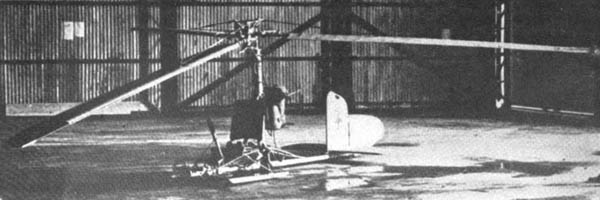U.S. intelligence report on the Focke-Achgelis Fa 330 Bachstelze (Wagtail) submarine rotor-kite. The Fa 330 was an unpowered rotary-wing kite, called a gyroglider or rotor-kite, towed behind German U-Boats during World War II to allow more distant observation. The Fa 330 was stowed in two watertight compartments in the submarine aft of the conning tower. The Fa 330 assisted in U-177’s spotting and sinking of the Greek steamer Efthalia Mari in 1943. The Allies captured the Fa 330 described below in May 1944 on the submarine U-852.
GERMAN SUBMARINE-BORNE OBSERVATION ROTOR-KITE
This article describes a new device used by German submarines to increase their range of observation. It is referred to by the British Air Ministry as a rotor-kite.
The newly-captured rotor-kite, for improving the eyes of German submarines, was recovered from a 1,200-ton U-boat. A photograph of this device appears as Fig. 7.
Fig. 7. German Submarine-Borne Observation Rotor-Kite
In operation, this kite is attached to and towed by the U-boat, lift being imparted as a result of the relative air velocity (wind + U-boat’s speed) turning the rotors, there being no engine. It is believed the height reached is between 325 and 500 ft. The tow cable is connected to the rotor kite by a quick release coupling, and it appears the other end is attached to an electric winch stowed on the forward deck of the U-boat. The winch controls the altitude and provides for the winding in.
The “fuselage” consists of a 2½” diameter tube 10′-6″ long. The rudder extends beyond the tube, the overall length being 13′-5½”. Immediately behind the pilot’s seat is a vertical column carrying the rotor head. This column is hinged to a lug on the fuselage to facilitate stowage.
Three vanes of 11″ chord are carried by the rotor head, the distance from vane tip to rotational axis being 12′. When at rest the weight of each vane is supported by a cable connected to the rotor head. Each vane is connected to the next by a slack cable which controls the angular spacing of the rotating vanes. At speeds above 50 rpm the lift on the vanes causes them to tilt slightly upward, the extent of this movement being limited by rubber stop blocks.
When not in the air, the aircraft rests on two bearer skids which are braced to the main fuselage tube and to the framework of the pilot’s seat. The stabilizer, fin and rudder assembly are readily detachable, and when dismantled the rotor kite is stowed vertically in a water tight hatch.
A rudder bar is pivoted at the forward end of the fuselage tube. There is also a control column whereby the rotor head may be tilted in relation to the vertical supporting column, thus varying the plane of rotation of the vanes. An electric tachometer is driven from the rotor head and has a lead connecting with the U-boat, wherein the revolution counter presumably is mounted. The pilot has a brake lever which controls the speed of the rotor head, and it must be assumed that the brake is applied in accordance with directions given from the U-boat control room over the intercommunication system. The latter also enables the pilot to report his observations.
To facilitate starting there is a rope pulley on the rotor head which enables an initial spin to be imparted. To permit a rapid descent in an emergency the rotor head complete with vanes may be jettisoned by operating a lever. The action of jettisoning automatically releases the parachute seen stowed on the vertical column behind the pilot’s seat. Simultaneously the cable connecting the rotor-kite to the U-boat is released. Presumably the rotor head would only be jettisoned in an emergency necessitating a crash dive. The pilot has an alternative method of releasing the connecting cable without jettisoning the rotor head or releasing the parachute.











Nice looking little helicopter – wouldn’t want to risk my life flying it.